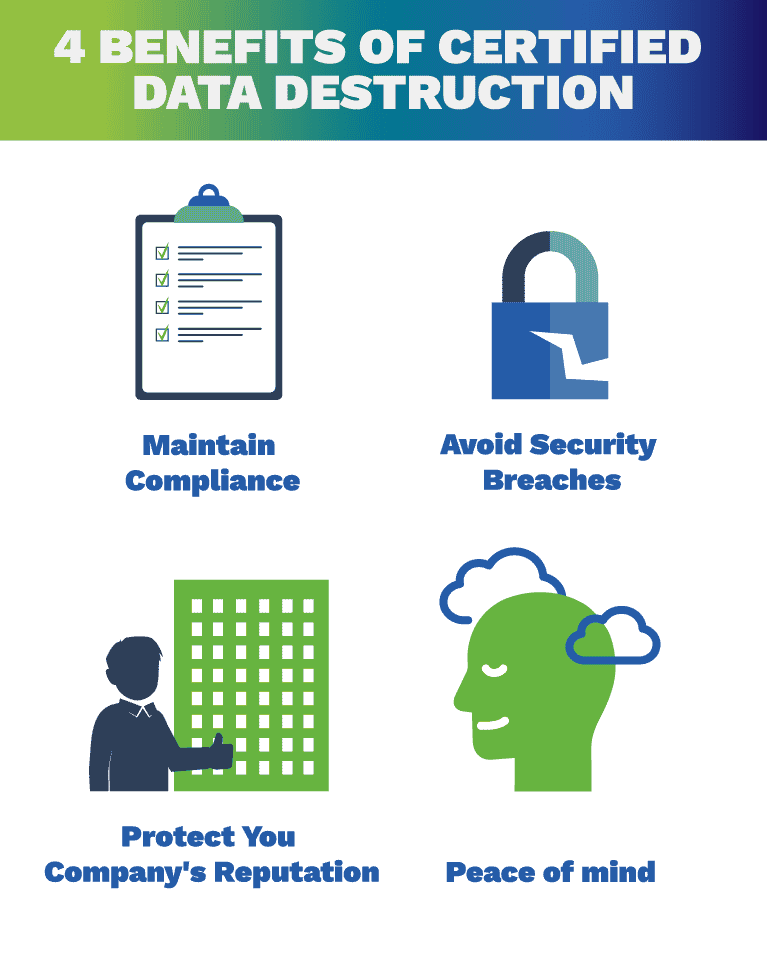Ideal Practices for Data Destruction to Fortify Your Cyber Security Structure
Ideal Practices for Data Destruction to Fortify Your Cyber Security Structure
Blog Article
Just How Proper Information Destruction Adds To Robust Computer Safety And Security Solutions and Mitigates Risks of Information Violations
In today's digital landscape, the importance of proper data devastation can not be overstated, as it acts as a basic element of detailed computer system protection solutions. By implementing efficient data erasure techniques, organizations not just shield delicate details from unauthorized accessibility however also strengthen their conformity with governing frameworks - data destruction. The ramifications of poor data destruction prolong beyond mere compliance; they can exceptionally impact a company's cybersecurity posture and online reputation. Understanding these dimensions elevates critical questions regarding the methods in location and their performance in an age of escalating cyber risks.
Value of Data Devastation
In today's electronic landscape, the importance of information devastation can not be overstated. As companies significantly rely upon digital assets, the potential dangers related to data breaches and unauthorized gain access to intensify. Efficient data destruction is an important component of a thorough details security strategy, securing delicate info from dropping right into the hands of destructive stars.
When information is no more needed, just deleting files or formatting disk drives wants. Residual data can frequently be recouped using conveniently available devices, positioning substantial hazards to both people and organizations. This underscores the necessity for robust data devastation methods that make sure all information is irretrievably eliminated.
Additionally, regulatory conformity mandates, such as GDPR and HIPAA, highlight the responsibility to shield sensitive data, including its proper disposal. Non-compliance can cause extreme economic charges and lawful repercussions. data destruction. Hence, incorporating reliable data damage protocols not just improves safety and security however additionally strengthens an organization's reputation and dependability

Approaches of Secure Information Erasure
A number of efficient techniques of protected information erasure can be used to make certain that delicate information is permanently eliminated from storage space gadgets. One commonly acknowledged approach is information overwriting, which entails replacing existing information with arbitrary patterns several times. This approach considerably decreases the possibilities of information recovery, although it might not be effective against sophisticated forensic methods.

Physical damage is also a reliable method, where storage space gadgets are provided unusable through shredding, squashing, or incineration. This method makes sure that data can not be recuperated whatsoever however requires mindful handling of dangerous materials.
Finally, specialized software application devices created for secure information erasure give functionalities that abide with different erasure criteria. These tools usually include attributes like confirmation processes to confirm successful data devastation.
Utilizing these techniques in mix can enhance information safety and alleviate the risks connected with data violations, guaranteeing that delicate details is not inadvertently revealed.
Legal and Compliance Factors To Consider
The methods utilized for protected information erasure not only offer to safeguard delicate info however additionally needs to line up with lawful and compliance structures controling information protection. Organizations are required to adhere to various policies, such as the General Information Protection Guideline (GDPR), the Medical Insurance Portability and Accountability Act (HIPAA), and the Payment Card browse around these guys Sector Data Protection Criterion (PCI DSS) These regulations mandate specific methods for data dealing with and destruction, guaranteeing that sensitive and personal data is irretrievably eliminated when no more required.
Failing to adhere to these lawful requirements can result in considerable penalties, including penalties and reputational damage. Additionally, companies need to keep documents of information destruction procedures, showing compliance throughout audits or examinations. This documentation not just safeguards against legal repercussions but also reinforces trust with clients and stakeholders, showcasing a commitment to data security.
Integrating legal and conformity considerations into information devastation practices is essential for any organization. It minimizes the risk of data violations and illustrates a proactive technique to securing sensitive information, eventually fostering a culture of security and accountability across the organization.
Impact on Cybersecurity Position
Effective information devastation significantly improves an organization's cybersecurity position by decreasing the potential strike surface area for cyber dangers. When delicate data is not appropriately damaged, it continues to be obtainable to harmful stars who can manipulate this details for unauthorized accessibility, identification theft, or business reconnaissance. By applying durable data destruction methods, companies can successfully reduce the threat of data breaches and boost their overall safety structure.
Furthermore, the safe and secure disposal of unnecessary or obsolete information not just secures sensitive information however likewise assists organizations abide by sector laws and requirements. Failure to sufficiently damage information can cause extreme legal effects and reputational damages, further compromising a company's cybersecurity position.

Inevitably, focusing on reliable information damage is necessary for cultivating a durable cybersecurity stance, guaranteeing that companies continue to be attentive against progressing cyber threats while securing their critical assets and stakeholders.
Finest Practices for Organizations
Implementing best practices for information damage is critical for organizations aiming to protect delicate details and mitigate cybersecurity risks. Firstly, organizations should establish a detailed information destruction plan that details duties and procedures. This policy ought to follow relevant guidelines, such as GDPR or HIPAA, guaranteeing lawful conformity.
Second of all, it is necessary to make use of approved data sanitization methods, consisting of data cleaning, degaussing, and physical destruction, tailored article source to the kind of information and storage medium. Employing qualified professionals for information destruction services boosts the integrity of these techniques.
Furthermore, companies need to keep an in-depth inventory of all information storage tools, making certain that all useful reference out-of-date or changed devices goes through damage. Normal audits of data destruction methods can assist enhance and identify weaknesses conformity.
Worker training is an additional essential facet, as team should recognize the significance of information devastation and comply with developed protocols. Ultimately, companies ought to record all information devastation activities to offer accountability and traceability, which can be indispensable throughout audits or in the event of a violation.
Conclusion

One commonly acknowledged technique is information overwriting, which entails changing existing data with arbitrary patterns numerous times.The techniques utilized for safe and secure data erasure not just offer to safeguard delicate info however likewise needs to line up with lawful and conformity frameworks controling data security. These regulations mandate certain methods for information handling and devastation, ensuring that individual and delicate data is irretrievably gotten rid of when no longer required.
By applying robust data damage methods, organizations can properly lessen the risk of data breaches and improve their overall safety and security structure.
In verdict, appropriate information devastation is important for boosting computer protection services and reducing the risks linked with information breaches. - data destruction
Report this page